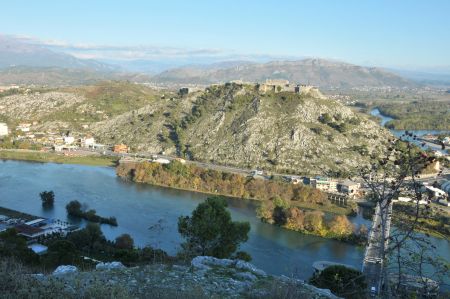Drin, Buna and Lake Shkodra - potential for tourism of Albania
- Written by Portal Editor
Our first stay in Shkodra already had surprised us because of the huge Lake Shkodra, the dams and rivers of the Drin, the Kir and the Buna not only with regard to the huge water surfaces but also the related ecosystems.
Even the dam projects are still predominantly used to generate electricity, Lake Shkodra and the river streams are already integrated into tourism and thus into the local economy. Slowly, however, the dams are also being explored. The Shurdhahi Island, which has already been described, can be mentioned here in the Vau-Deja Reservoir, which is slowly becoming a tourist destination due to the ruins of Sarda and its location. The same is true for the Komani Reservoir and its legendary canyon ferry, which is increasingly gaining in importance for travelers to the Valbona Valley.
Black Drin has its source at Lake Ohrid in Macedonia
In our articles on Struga on the Ohrid Lake in Macedonia, we had already referred to the Black Drin's origin, well known for the Ohrid Lake in the center of Struga due to its spectacularly draining into this river. At the outflow at an altitude of about 695 m, the Black Drin flows 149 kilometers northwards through the mountainous landscape of West Macedonia and Northeastern Albania.
In Macedonia, the river already has two reservoirs, the Globočica Lake and the Debar Lake directly at Debar. Shortly after the large dam of Lake Debar, it reaches the border with Albania, which it forms for a few kilometers. After that, it entirely moves to Albanian territory. The further course of the river in Albania stretches north through low-populated, mountainous and impassable landscapes to the first dam project near Fierza, namesake of the highest dam on the Albanian side. A little further down is the Komani Lake with its impressive rock and canyon landscape and finally to the Vau-Deja reservoir, all of which are hydroelectric power stations along the Drin River.
Shortly after the last-mentioned dam, the Drin separates in the coastal plain of North-Albania by bifurcation, a branching or bifurcation of a flowing body of water so that its water flows into two different river systems. Soil subsidence or the floods in the years 1858/59 led to the fact that the water masses were looking for a new way, which probably corresponds to the way in antiquity.
Black Drin - changing its direction during the history
The Old Drin, a very small river, which today is mainly fed by the influx of Gjadër, runs south through the Zadrima Plain. This was once the only river. A little west of the city of Lezha, where it crosses a path between two hills, it reaches the Adriatic Sea in the Drin Gulf. In the flat coastal plain, it has formed a large lagoon system over the millennium. The headland north of the Drin delta is called Kuna, the south of it Vain.
The second, larger river bank (also called Huge Drin, Drin / -i i Madh) runs westwards. The Ashta Hydroelectric Power Plant, opened in 2012 at the United Drin, just below the Vau-Deja reservoir, is the first to meet. Afterwards, the Drin crosses the southern edge of the city of Shkodra, where it is, not far from the Rozafa Castle near Bahçallëk, meeting with the Buna (Bojana / Боја), which has just left Lake Shkodra.
Beautil view on Black Drin, Buna and Lake Shkodra from Rozafa Castle
The Buna, which forms the border between Albania and Montenegro during more than half the route, reaches the Adriatic at 32 kilometers later. The estuary is located about 20 kilometers northwest of the mouth of the southern Drin-arm also on the Drin-Golf. In contrast to the Drin, the Buna is navigable by boat.
In the flooded river valley, older maps still show various villages. The area around the Vau-Deja reservoir, on the other hand, has been sparsely populated since the congestion. The almost uninhabited nature is ideal as a tourist recreation area to various activities of hiking, cycling and also many water sports.
Please read as well:
Peaks of the Balkans - Long distance trail passing Valbona
Koman Lake and Dam - more impressions about the ferry trip
The added pictures are taken from different viewpoints at Rozafa Castle and opposite mountain range.
-
-
-
-
-
-
-
-
-
-
-
-
-
-
-
-
-
-
-
-
-
https://www.alaturka.info/en/albania/shkoder/3949-drin-buna-and-lake-shkodra-potential-for-tourism-of-albania/amp#sigProIdc00e05e685
